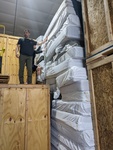Osteoporosis is the inevitable consequence of a spinal cord injury (SCI) and represents a major complication that results in lower extremity fractures in approximately half of the SCI population. Fracture related complications occur in half of SCI patients who suffer a lower extremity fracture resulting in prolonged hospitalizations because of soft tissue infections, decubitus ulcers, non-unions, and blood clots. Despite the significant morbidity and occasional mortality associated with osteoporosis related fractures in SCI patients, there currently is no best practice clinical practice published to guide providers.
Osteoporosis is a musculoskeletal disease characterized by low bone mass that leads to brittle bones prone to fracture. In the non-spinal cord injury population it is related to both musculoskeletal disuse and hormonal influences. In SCI the resulting bone lose is uniquely fast leading to an approximate loss of 40% of the bone mineral density below the level of the injury. There is also a disproportional loss of bone mineral density at the distal femur and proximal tibia and it is not uncommon for fractures in these locations to occur with mere bed to chair transfers or even rolling in bed.
Hospitalizations for fracture related diagnoses in patients with SCI are most common at the tibia/fibula, distal femur, and proximal femur near the hip. Falls from the wheelchair is the most common cause of fractures followed by traction injuries to the legs during wheelchair transfers. Management is usually treated non-surgically with bed rest or bracing in eight-five percent of patients. Hip fractures are the most common fracture in the SCI population that requires surgical management to allow for early mobilization and sitting.
An unfortunate consequence of lower extremity fractures is the complications associated with fracture management in the community. SCI patients simply cannot be managed the same way as patients who walk. Patients with SCI generally do poorly in casts since they do not have the sensation required to identify soft tissue compression from a tight cast. These patients will need bracing with frequent skin checks by nursing or family members under the brace to ensure there is no skin breakdown. SCI patients with fractures are at risk for blood clots, soft tissue infections, and decubitus ulcers.
Distal femur fractures and proximal tibia fractures often require a knee immobilizer for six to eight weeks. Functionally these patients will often need assistance with bed to chair transfers, activities of daily living, and some times wheelchair pressure reliefs to avoid decubitus ulcers. It is advisable that SCI patients with lower extremity fractures receive care at an acute rehabilitation hospital to ensure complications are avoided.
Treatment of SCI induced osteoporosis has been shown to slow down the bone loss related to osteoporosis but does little to induce bone formation. Acute spinal cord injury is associated with significant increase in calcium in the urine related to a rapid resorption of bone. There are no current recommendations regarding calcium supplements or Vitamin D supplement in the acutely injured spinal cord patient. Acutely and chronically injured spinal cord patients appear to benefit from standing activities, functional electrical stimulation cycling, and vibration therapy that appears to strengthen bone
SCI patients with osteoporosis diagnosed by way of a DEXA-Scan should have a thyroid function test and Vitamin D level. They will likely require calcium supplements of 2000 milligrams a day and Vitamin D 1000 units per day. Bisphosphonate drugs such as Fosamax has been shown to slow down bone loss for both the acutely and the chronically injured SCI patient.
An Academic Physician Life Care Planner understands how the level of injury, the completeness of injury, and other individual factors that place a spinal cord injured person at risk for osteoporosis related fractures. A comprehensive life care plan must include all medical and non-medical goods and services to prevent complications from this inevitable musculoskeletal disease associated with SCI that will include the following: 1) Standing frame, 2) FES-Cycle, 3) Periodic DEXA-Scan, 4) Calcium supplements, 5) Vitamin D supplements, 6) Orthopedic follow up, 7) Inpatient Rehabilitation, 8) Home assistance, and 9) Biosphosphonate medications.
http://link.springer.com/article/10.1007/s00198-008-0671-6#page-1
http://link.springer.com/article/10.1007/s11914-012-0117-0#page-1
http://link.springer.com/article/10.1007/s00198-005-2028-8#page-1
Press Contact
Dr. Greg Vigna, MD, JD Academic Physician Life Care Planner
T: 800-761-9206
Connect with Dr. Greg Vigna, MD, JD
on Facebook, Twitter, or Google+
#DrGregVigna
News Provided By: Submit Press Release 123







